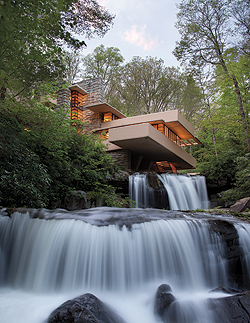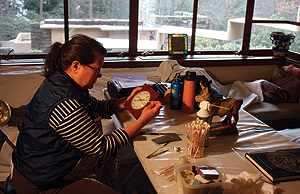Fallingwater’s Rich Symbolism Lives On
The American Institute of Architects named it the “best all-time work of architecture.” Edgar Kaufmann, jr., said “it is a work by man for man, not by a man for a man.” Frank Lloyd Wright called it a “one of the great blessings to be experienced here on earth.”

Fallingwater stands as testament to one man’s imagination, one family’s generosity and one place’s ability to symbolize how people may live in harmony with nature.
Fallingwater was built in 1936 by Edgar Kaufmann, Sr., owner of Pittsburgh’s Kaufmann’s department store, as a mountain retreat for his family. He hired Wright – then 67, with a faltering career – to design their weekend home. Fallingwater became Wright’s “phoenix” and reestablished him as a force in architecture.
In 1963, Edgar Kaufmann jr. entrusted Fallingwater, its buildings and grounds to the Western Pennsylvania Conservancy. Included with this gift were 1,543 acres surrounding the house and Bear Run creek. The gift also included objects, furniture and artwork that were part of the house – making Fallingwater the only major Wright residence to come into the public trust with furnishings and collections intact.
Kaufmann’s words regarding this gift capture Fallingwater’s ability to inspire in all who visit a deep appreciation of nature:
“Why are these acres and the house given as a conservation, in the care of Western Pennsylvania Conservancy? Because conservation is not preservation: preservation is stopping life to serve a future contingency; conservation is keeping life going. The union of powerful art and powerful nature into something beyond the sum of their separate powers deserves to be kept living. As the waterfall of Bear Run needed the house to enter the realm of art, so the joint work of art, Fallingwater in its setting, needed Western Pennsylvania Conservancy to enter a new life of public service. I believe the Conservancy will give nature, the source, full due, and art, the human response, full respect.”
However, the unique demands of preserving Fallingwater, combined with an inadequate endowment, have prevented the Conservancy from maximizing Fallingwater’s tremendous potential. Our goals during the decade include:
- • Expanding educational programming;
- • Building sustainable cottages to host visiting scholars, artists and students;
- • Replacing the failing window glass with a state-of-the-art glass system and creating a permanent endowment for future glass replacement;
- • Fostering a more welcoming experience for all guests by redesigning the visitor parking areas and renovating for universal access to the Visitors Center;
- • Increasing the endowment for curatorial, educational and programming needs.
Room to Grow
The growth of Fallingwater’s on-site educational programming has been stunted by its shortage of lodging and studio space.
The Conservancy envisions creating a community at Fallingwater where individuals of all ages can participate in a variety of programming that explores the ideas that informed Fallingwater, as well as current thinking regarding design, sustainable architecture, landscape architecture, conservation and natural history. Workshops would vary in length from a few days to a full week and will be geared to specific interests and ages.
In order to make that vision a reality, WPC plans to build six cottages that will provide lodging for up to 20 people (the enrollment of a typical program). The beauty of the cottages is that they will actively demonstrate the principles the Conservancy and Fallingwater espouse in programming: sustainable design and conservation.
A design competition for the cottages was held in 2010; the winner was Patkau Associates, Vancouver, B.C., whose design was recognized by the jurors as forward thinking in terms of sustainability and the environment. It was also lauded for a subtle integration with the landscape.
Protecting Wright’s Original Vision
 Victoria Jefferies, a wood conservator, works on
some of the objects in the Fallingwater collections.
Victoria Jefferies, a wood conservator, works on
some of the objects in the Fallingwater collections.
To connect the house to its dramatic landscape over the waterfall, Wright used an extensive amount of glass in the building. However, Fallingwater’s window glass is delaminating, causing cloudiness and compromising its UV protection capabilities. WPC must replace this glass, not only to restore the seamless transition between interior and exterior spaces that Wright intended, but also to protect the woodwork and priceless collections from damaging heat, sunlight and UV radiation.
